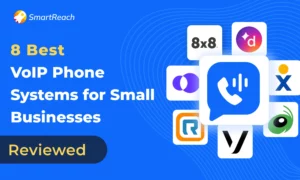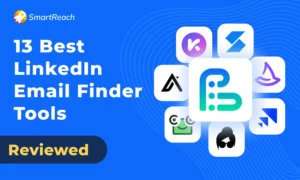Cold Email Best Practices: Tips, Templates & Spam-Proofing
To write effective cold emails in 2025, research your prospect, use a personalised opener, use a short and benefit-driven subject line, keep the email body under 90 words, include one clear CTA, follow up 3–5 times, and ensure deliverability with SPF/DKIM/DMARC authentication.
Ready to scale your outbound lead generation?
Learning how to write a cold email will be critical for your success with cold email prospecting.
What is a cold email?
A cold email is an unsolicited message sent to a potential customer or prospect with the aim of starting a conversation or generating interest in a product or service. Unlike spam, a well-crafted cold email is personalized, relevant, and designed to provide value from the first line.
Why do cold emails still work for lead generation?
Despite the rise of social media and other outreach channels, cold emails remain one of the most effective ways to connect with prospects for several reasons:
- Direct access to decision-makers: Email is still the preferred communication channel for professionals in the B2B outreach.
- Scalable personalization: With a cold email automation tool, you can send hundreds of hyper-personalized emails quickly.
- Measurable impact: Open rates, click-through rates, and reply rates can be tracked precisely, helping optimize campaigns.
- Cost-effective: Compared to paid ads or outbound calls, cold emails offer high ROI when done correctly.
What are the best practices for writing converting cold emails?
Follow these proven tactics to get the most out of the cold email campaigns –
1. Research your prospects
Understand their company, role, and pain points. Use LinkedIn, news, and their website to gather insights for personalization.
2. Craft short, benefit-driven email subject lines
Keep it 4–7 words, highlight value, and personalize with the recipient’s name or company.
Avoid clickbait or spammy phrasing in the email subject lines.
Read more: 165 B2B Cold Email Subject Lines For Sales Outreach
3. Personalize email opening lines
The first 1–2 lines should reference a relevant insight about the recipient, like a recent achievement, blog post, or challenge.
4. Keep the email body short & focused
50–90 words is ideal. Focus on one problem and one clear solution, avoid fluff.
Read more: How to Write Cold Email Subject Line & Body Copy?
5. Include a single, clear call-to-action
Ask one focused question or suggest a meeting/demo time.
Don’t overwhelm the email recipients with multiple CTAs.
6. Follow-up 3–5 times
Space emails follow-ups 2–5 business days apart. Each follow-up should provide new value or a different angle.
7. Get to the point fast
You have a very limited window to get your prospects time. Move with your most compelling parts of info, and make it good!

8. Put all contact info in the email signature
Make it simple for your prospect to do a little Sherlock Holmes work by styling your signature & including the links you want them to see.
Be precise about this, less is better in many cases.
9. Avoid images in the email body
Images are big culprits and they effect email deliverability.
Avoid using images unless absolutely necessary in the email sequence.
10. A/B test your emails
Try testing different email subject lines, offers, CTAs and timing in the campaigns. Benchmark the performances and optimize the campaigns accordingly.
11. Stay consistent
Even if you feel like, Don’t ever quit!
It can be a numbers game on some level, and a stalwart attentiveness to sales prospecting can bear a lot of fruit over time!
Some cold email templates you can use
Here are 4 ready-to-use templates for common outreach scenarios.
Customize placeholders for best results.
Template #1 — Introductory Cold Email
| SUBJECT: Quick question about [Company’s growth/goal] OPENER: Hi [First Name], I noticed [specific detail about their company/product/role]. VALUE: Companies like [prospect’s competitor/peer] have used [your solution] to achieve [specific outcome, e.g., 20% faster onboarding]. CTA: Would you be open to a 15-minute chat next week to see if this could work for you? |
Template #2 — 1st Follow-up (After no reply)
| SUBJECT: Just wanted to follow up, [First Name] OPENER: Hi [First Name], I know your time is valuable so I’ll keep this short. VALUE: Many [industry/role] teams I work with faced [pain point], and they saw results like [quantifiable outcome] after using [solution]. CTA: Is [day/time] a good time for a quick call to discuss if this is relevant for you? |
Template #3 — 2nd Follow-up (value add)
| SUBJECT: Thought you might find this useful OPENER: Hi [First Name], since we last connected, I found this [article/report/case study] on [topic relevant to prospect]. VALUE: It highlights how teams like yours solve [pain point]. We’ve seen [solution] help companies save [X hours/costs]. CTA: Would you like me to share a quick walkthrough tailored to [Company’s situation]? |
Template #4 — Break-Up Email
| SUBJECT: Should I close the loop? OPENER: Hi [First Name], I haven’t heard back, so I don’t want to keep bothering you. VALUE: We’ve helped [role/company type] solve [pain point], but I’ll assume this isn’t a priority for you right now. CTA: If you’d like, I can reach out later in the year — otherwise, wishing you continued success! |
For more cold email templates, check out our blog “200+ Cold Email Templates to Get Replies“
Common cold email mistakes to avoid
- Generic emails: Not personalizing the message reduces response rates.
- Overly long emails: Long messages overwhelm the recipient and get ignored.
- Too many CTAs: Confusing calls-to-action dilute effectiveness.
- Ignoring deliverability: Sending from unverified domains leads to spam placement.
- Neglecting follow-ups: Most responses come from second or third follow-ups.
Next steps
Start applying these best practices today.
Use the ready-made templates, follow the best practices and track your results.
For automated cold email campaigns with high deliverability, try SmartReach.io and improve your cold email outreach at scale.
Try SmarReach.io for FREE. (Sign-up link added)
No credit card needed for the sign-up.
F.A.Qs
Q. What are the best practices for cold emails?
The best practices for cold emails include researching the prospect, writing a personalized opener, using a clear subject line, keeping the body under 90 words, asking one CTA, and following up 3–5 times.
Q. How many follow-ups should a cold email sequence have?
A cold email sequence should usually include 3–5 follow-ups, spaced 2–5 business days apart. Each follow-up should add new value or context instead of repeating the same message.
Q. What subject lines get the best open rates for cold emails?
Cold email subject lines that perform best are short (4–7 words), personalized with the recipient’s name or company, and curiosity-driven without being clickbait. Always A/B test subject lines to refine performance.
Q. How can I avoid cold emails going to spam?
To avoid cold emails going to spam, authenticate your sending domain with SPF, DKIM, and DMARC, warm up new domains, gradually scale sending, avoid spam trigger words, and monitor bounce rates.
Q. What is the best time to send a cold email?
The best time to send a cold email is typically Tuesday to Thursday mornings (8–11 AM) in the recipient’s local time zone. Testing different time windows helps optimize for your specific audience.




